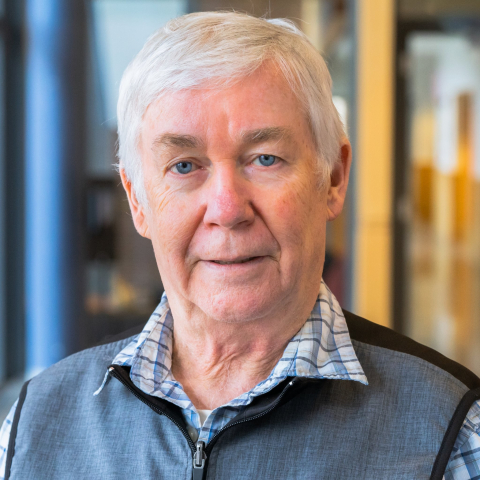Daniel Cosgrove
Eberly Chair and Professor of Biology

-
350A Frear North
University Park, PA - He/Him
- fsl@psu.edu
- 814-863-3892
Research Summary
Mechanism of plant growth. Function and evolution of expansins. Biochemistry and rheology of plant cell walls. Growth responses to light, hormones, and water stress and other stimuli.
Huck Affiliations
- Plant Biology
- Molecular, Cellular, and Integrative Biosciences
- Plant Institute
- Center for Biorenewables
- Center for Root and Rhizosphere Biology
Links
Most Recent Publications
How Many Glucan Chains Form Plant Cellulose Microfibrils? A Mini Review
Daniel J. Cosgrove, Paul Dupree, Enrique D. Gomez, Candace H. Haigler, James D. Kubicki, Jochen Zimmer, 2024, Biomacromolecules on p. 6357-6366
Review of: Plant Cell Walls - Research Milestones and Conceptual Insights.
Daniel Cosgrove, 2024, Annals of botany
Plant Cell Wall Loosening by Expansins
Daniel J. Cosgrove, 2024, Annual Review of Cell and Developmental Biology on p. 329-352
The structure and interaction of polymers affects secondary cell wall banding patterns in Arabidopsis
Sarah A. Pfaff, Edward R. Wagner, Daniel J. Cosgrove, 2024, Plant Cell on p. 4309-4322
Top five unanswered questions in plant cell surface research
Wout Boerjan, Vincent Burlat, Daniel J. Cosgrove, Christophe Dunand, Paul Dupree, Kalina T. Haas, Gwyneth Ingram, Elisabeth Jamet, Debra Mohnen, Steven Moussu, Alexis Peaucelle, Staffan Persson, Cătălin Voiniciuc, Herman Höfte, 2024, The Cell Surface
Mechanobiology: Shaping the future of cellular form and function
Celeste M. Nelson, Bailong Xiao, Sara A. Wickström, Yves F. Dufrêne, Daniel J. Cosgrove, Carl Philipp Heisenberg, Sirio Dupont, Amy E. Shyer, Alan R. Rodrigues, Xavier Trepat, Alba Diz-Muñoz, 2024, Cell on p. 2652-2656
Single-molecule tracking reveals dual front door/back door inhibition of Cel7A cellulase by its product cellobiose
D Nong, Zachary Haviland, Nerya Zexer, Sarah Pfaff, Daniel Cosgrove, M Tien, Charles Anderson, William O. Hancock, 2024, Proceedings of the National Academy of Sciences of the United States of America on p. e2322567121
Dynamic Structural Change of Plant Epidermal Cell Walls under Strain
J Yu, J Del Mundo, G Freychet, M Zhernenkov, E Schaible, Esther W. Gomez, Enrique D. Gomez, Daniel Cosgrove, 2024, Small on p. e2311832
The nonlinear mechanics of highly extensible plant epidermal cell walls
Jingyi Yu, Yao Zhang, Daniel J. Cosgrove, 2024, Proceedings of the National Academy of Sciences of the United States of America
Tissue-specific directionality of cellulose synthase complex movement inferred from cellulose microfibril polarity in secondary cell walls of Arabidopsis
Juseok Choi, Mohamadamin Makarem, Chonghan Lee, Jongcheol Lee, S Kiemle, Daniel Cosgrove, Seong Kim, 2023, Scientific Reports on p. 22007
Most-Cited Papers
Plant cell wall extensibility: Connecting plant cell growth with cell wall structure, mechanics, and the action of wall-modifying enzymes
Daniel J. Cosgrove, 2016, Journal of Experimental Botany on p. 463-476
Lignin-polysaccharide interactions in plant secondary cell walls revealed by solid-state NMR
Xue Kang, Alex Kirui, Malitha C. Dickwella Widanage, Frederic Mentink-Vigier, Daniel J. Cosgrove, Tuo Wang, 2019, Nature Communications
Plant expansins: Diversity and interactions with plant cell walls
Daniel J. Cosgrove, 2015, Current Opinion in Plant Biology on p. 162-172
Xyloglucan and its interactions with other components of the growing cell wall
Yong Bum Park, Daniel J. Cosgrove, 2015, Plant and Cell Physiology on p. 180-194
Diffuse growth of plant cell walls
Daniel Cosgrove, 2018, Plant Physiology on p. 16-27
Cellulose-pectin spatial contacts are Inherent to never-dried Arabidopsis primary cell walls: Evidence from solid-state nuclear magnetic resonance
Tuo Wang, Yong Bum Park, Daniel J. Cosgrove, Mei Hong, 2015, Plant Physiology on p. 871-884
Molecular insights into the complex mechanics of plant epidermal cell walls
Yao Zhang, Jingyi Yu, Xuan Wang, Daniel M. Durachko, Sulin Zhang, Daniel J. Cosgrove, 2021, Science on p. 607-711
Spatial organization of cellulose microfibrils and matrix polysaccharides in primary plant cell walls as imaged by multichannel atomic force microscopy
Tian Zhang, Yunzhen Zheng, Daniel J. Cosgrove, 2016, Plant Journal on p. 179-192
Catalysts of plant cell wall loosening
Daniel J. Cosgrove, 2016, F1000Research
Xyloglucan deficiency disrupts microtubule stability and cellulose biosynthesis in arabidopsis, altering cell growth and morphogenesis<sup>1[OPEN]</sup>
Chaowen Xiao, Tian Zhang, Yunzhen Zheng, Daniel J. Cosgrove, Charles T. Anderson, 2016, Plant Physiology on p. 234-249
News Articles Featuring Daniel Cosgrove
Oct 31, 2024
Stem cell-like approach in plants sheds light on specialized cell wall formation
New method reprograms isolated plant cells to form other cell types.
Full Article
May 07, 2024
Why is breaking down plant material for biofuels so slow?
Breaking down cellulose for biofuel is slow and inefficient but could avoid concerns around using a food source while taking advantage of abundant plant materials that might otherwise go to waste. New research led by Penn State investigators has revealed how several molecular roadblocks slow this process.
Full Article
May 13, 2021
What makes plant cell walls both strong and extensible?
A plant cell wall’s unique ability to expand without weakening or breaking — a quality required for plant growth — is due to the movement of its cellulose skeleton, according to new research that models the cell wall.
Full Article
Feb 04, 2020
Herringbone pattern in plant cell walls critical to cell growth
Plant cells tend to grow longer instead of wider due to the alignment of the many layers of cellulose that make up their cell walls, according to a new study that may have implications for biofuels research.
Full Article
Nov 20, 2019
Eleven Eberly faculty featured as highly cited researchers in 2019 by Clarivate
Eleven researchers from the Eberly College of Science have been recognized as "highly cited" by the Clarivate Analytics Web of Science Group. The 2019 Highly Cited Researchers list features researchers who have demonstrated considerable influence through publication of multiple works that have been cited by a significant number of their peers during the last decade.
Full Article